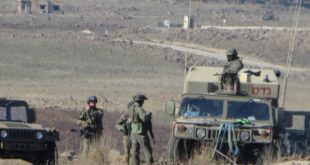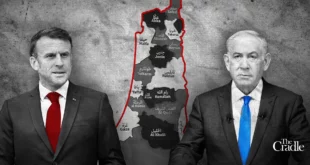Note: The data cut-off for this product was 11:45am ET on February 13. ISW will cover subsequent reports in the February 14 Russian Offensive Campaign Assessment.
Ukraine’s European partners announced new military assistance to Ukraine amid the February 12 Ukraine Defense Contact Group (the Ramstein format) meeting. The United Kingdom (UK) pledged 150 million pounds (about $188 million) in military support, including drones, “dozens” of battle tanks and armored vehicles, and air defense systems, and confirmed plans to provide Ukraine with an additional 4.5 billion pounds (about $5.6 billion) worth of military assistance in 2025.[1] The UK stated that it will provide Ukraine will over 50 armored and protective vehicles, including modernized T-72 tanks, by the end of Spring 2025.[2] Germany committed to supplying 100 IRIS-T air defense system missiles to Ukraine in the near future, and German defense company Helsing announced the delivery of 6,000 AI-equipped drones to Ukraine.[3] Norway joined the Ukrainian Drone Coalition and revealed plans to establish and equip Ukraine’s “Northern Brigade” as part of a broader Nordic initiative in which the Nordic countries will equip and train one Ukrainian battalion each.[4] The Netherlands announced the delivery of 25 YPR armored infantry vehicles, Latvia announced the donation of 42 armored personnel carriers, and Estonia also pledged to allocate 0.25 percent of its GDP for military assistance to Ukraine in 2025.[5]
Russia reportedly lost just over 5,000 tanks and armored vehicles during 2024 compared with 3,000 in 2023. The British International Institute for Strategic Studies (IISS) estimated on February 10 that Russia lost 1,400 main battle tanks (roughly four tank divisions’ worth) and over 3,700 infantry fighting vehicles (IFVs) and armored personnel carriers (APCs) — totaling 5,100 lost tanks and armored vehicles in 2024.[6] Data from the Ukrainian General Staff indicates that Ukrainian forces damaged or destroyed over 3,000 Russian tanks and almost 9,000 armored vehicles in 2024, and IISS’ estimates likely only account for destroyed tanks and armored vehicles.[7] IISS assessed in February 2024 that Russia would be able to sustain its then-rate of vehicle losses (over 3,000 tanks, APCs, and IFVs annually as of 2023) until February 2026 or 2027 by refurbishing vehicles from Soviet-era storage facilities.[8] It remains unclear if the Russian military command will remain willing or able to sustain this increased rate of armored vehicle losses in 2025, as Russian forces appear to be adapting their tactics to limit such losses.
IISS noted that Russia has adapted some of its tactics to address ongoing equipment shortages and is increasingly relying on infantry-led assaults to advance along the frontline.[9] ISW began observing indications in November and December 2024 that Russian forces were using fewer armored vehicles in Donetsk Oblast, particularly in areas where Russian forces had previously relied heavily on mechanized assaults to make significant tactical advances.[10] Russian forces have continued to use fewer armored vehicles in Donetsk Oblast and throughout the frontline, possibly due to Ukrainian drone operations, equipment constraints, or non-conducive ground conditions brought about by rainy weather. Khortytsia Group of Forces Spokesperson Major Viktor Trehubov stated on February 13 that successful Ukrainian drone strikes have been the main factor — and not poor weather and ground conditions — prompting Russian forces to use fewer armored vehicles along the frontline.[11] Trehubov noted that Russian forces also have issues supplying shells to some unspecified frontline positions, possibly due to successful Ukrainian strikes against Russian ammunition depots, and have thus decreased the intensity of shelling in such areas.
It remains unclear if Russia can repair and newly-produce a sufficient number of tanks and armored vehicles to replace losses in Ukraine and equip new Russian units. IISS assessed that Russia refurbished and built over 1,500 tanks and 2,800 IFVs and APCs in 2024 — suggesting that Russia produced enough vehicles to replace all of its tank losses and three quarters of its armored vehicle losses last year.[12] IISS assessed that Russia’s ongoing effort to expand the Russian military and create new units is exacerbating equipment shortages and noted that Russia may also be suffering from a shortage of spare parts to refurbish tanks and armored vehicles. IISS assessed that it is highly likely that the Soviet-era tanks and armored vehicles remaining in Russia’s stores are in a deteriorated condition, which may complicate Russia’s ability to offset high equipment losses in 2025 and beyond. Ukrainian President Volodymyr Zelensky, citing Ukrainian intelligence, reported on February 8 that Russia is continuing to form new divisions, and former Russian Defense Minister and Security Council Secretary Sergei Shoigu announced in March 2023 that Russia aimed to stand up 14 new military divisions in the coming years.[13] The Russian military command appears to be balancing allocating refurbished and newly-produced vehicles between new formations and formations that have been fighting on the frontline for several years. Russia may struggle to adequately equip its units with materiel in the long-term if the Russian military continues to burn through Soviet-era vehicle stocks without significantly increasing Russia’s ability to produce new tanks and armored vehicles.
Estonia’s Foreign Intelligence Service (EFIS) assessed that Russia is attempting to build its capabilities not only to support Russia’s war effort in Ukraine but also to prepare for a potential future war with NATO, which is consistent with ISW’s assessments about ongoing Russian efforts to prepare its military and society for a future conflict with NATO in the medium to long-term. The EFIS published its annual intelligence report on February 12 which focused on Russian threats to Estonia, other NATO members, and the West.[14] The intelligence report noted that the pace of the Russian military’s rearmament will depend on the duration and outcome of Russia’s war in Ukraine. The EFIS also assessed that a cessation or freeze of the war in Ukraine on terms favorable to Russia would allow Russia to permanently station more forces along the borders of NATO member states neighboring Russia than before Russia’s full-scale invasion of Ukraine in February 2022 – consistent with ISW’s longstanding assessments.[15] The intelligence report highlighted Russia’s efforts to increase, improve, and centralize drone operations and production.[16] The EFIS reported that Russia will allocate on average one million euros (about $1 million) annually until 2030 to its “Unmanned Aerial Vehicle” National Project, established in December 2023, which aims to establish 48 research and production centers across Russia, standardize drone productions and development, create an electronic database of drone industry experts, and integrate drone-related education into 75 percent of all Russian schools.[17] The EFIS assessed that Russia is attempting to use these research and development centers to reduce Russia’s reliance on Western and foreign technology and components and that Russia continues to rely on the People’s Republic of China (PRC) to procure Western components for drone production. The EFIS noted that up to 80 percent of sanctioned Western components likely reach Russia through the PRC.
Ukrainian forces continue to target Russian energy and military infrastructure as part of an ongoing strike campaign against Russian defense industrial enterprises. Ukraine’s Main Military Intelligence Directorate (GUR) announced on February 13 that Ukrainian drones destroyed two Valdai radar complexes in Dolgoprudny, Moscow Oblast and noted that Russian forces used the radar complexes to detect and down drones over the airspace near Moscow City.[18] Lipetsk Oblast Governor Igor Artamonov claimed on February 13 that Ukrainian drones targeted the Lipetsk water aeration station in Lipetsk City, and a Russian source claimed that Ukrainian drones targeted the Novolipetsk Metallurgical Plant, which is located near the station and produces about 20 percent of Russia’s steel output.[19] Ukrainian outlet Suspilne, citing sources in Ukraine’s Security Service (SBU), reported on February 13 that the SBU struck the Andreapol oil pumping station in Tver Oblast, causing a fire at the boiler equipment warehouse and a closed switchgear.[20]
The Moldovan Ministry of Foreign Affairs (MFA) announced on February 13 the termination of the Moldovan-Russian Intergovernmental Agreement on the establishment and functioning of Russian cultural centers in Moldova in response to ongoing reports of Russian drones violating Moldovan airspace.[21] The Moldovan MFA noted that it summoned Russian Ambassador to Moldova Oleg Vasnetsov following Russian drone violations of Moldovan airspace and notified Vasnetsov of the intended closure of the local branch of the Russian Federal Agency for the Commonwealth of Independent States (CIS), Compatriots Living Abroad, and International Humanitarian Cooperation (Rossotrudnichestvo), a Russian cultural diplomacy agency, in response.[22] Moldovan President Maia Sandu reported on February 13 that Russian Shahed drones violated the country’s airspace and that two drones exploded on Moldovan territory.[23] Vasnetsov denied reports that Russian drones violated Moldovan territory.[24] Geolocated footage published on February 13 shows the explosion and aftermath of a likely Russian Shahed strike in a field near Ceadir-Lunga, Moldova.[25] Azerbaijani outlets also reported on February 6 that Azerbaijani authorities announced the closure of the local Rossotrudnichestvo branch in Baku, Azerbaijan citing national security concerns and a move away from “external interference.”[26] Russia currently has over 80 Rossotrudnichestvo branches concentrated in Europe, Africa, Latin America, and Central and Southeast Asia aimed at promoting Russian culture, strengthening the influence of the Russian language, supporting “compatriots abroad,” and preserving historical sites abroad with significance to Russia.[27] Moldovan and Ukrainian officials have previously warned that Russian officials use the branches to promote Russian propaganda and conduct “subversive work” abroad.[28]
Key Takeaways:
Ukraine's European partners announced new military assistance to Ukraine amid the February 12 Ukraine Defense Contact Group (the Ramstein format) meeting.
Russia reportedly lost just over 5,000 tanks and armored vehicles during 2024 compared with 3,000 in 2023.
IISS noted that Russia has adapted some of its tactics to address ongoing equipment shortages and is increasingly relying on infantry-led assaults to advance along the frontline.
It remains unclear if Russia can repair and newly-produce a sufficient number of tanks and armored vehicles to replace losses in Ukraine and equip new Russian units.
Estonia's Foreign Intelligence Service (EFIS) assessed that Russia is attempting to build its capabilities not only to support Russia's war effort in Ukraine but also to prepare for a potential future war with NATO, which is consistent with ISW's assessments about ongoing Russian efforts to prepare its military and society for a future conflict with NATO in the medium to long-term.
Ukrainian forces continue to target Russian energy and military infrastructure as part of an ongoing strike campaign against Russian defense industrial enterprises.
The Moldovan Ministry of Foreign Affairs (MFA) announced on February 13 the termination of the Moldovan-Russian Intergovernmental Agreement on the establishment and functioning of Russian cultural centers in Moldova in response to ongoing reports of Russian drones violating Moldovan airspace.
Russian forces recently advanced near Borova and Siversk.
Russian officials continue efforts to increase recruitment for the "BARS-Bryansk" volunteer territorial defense detachment.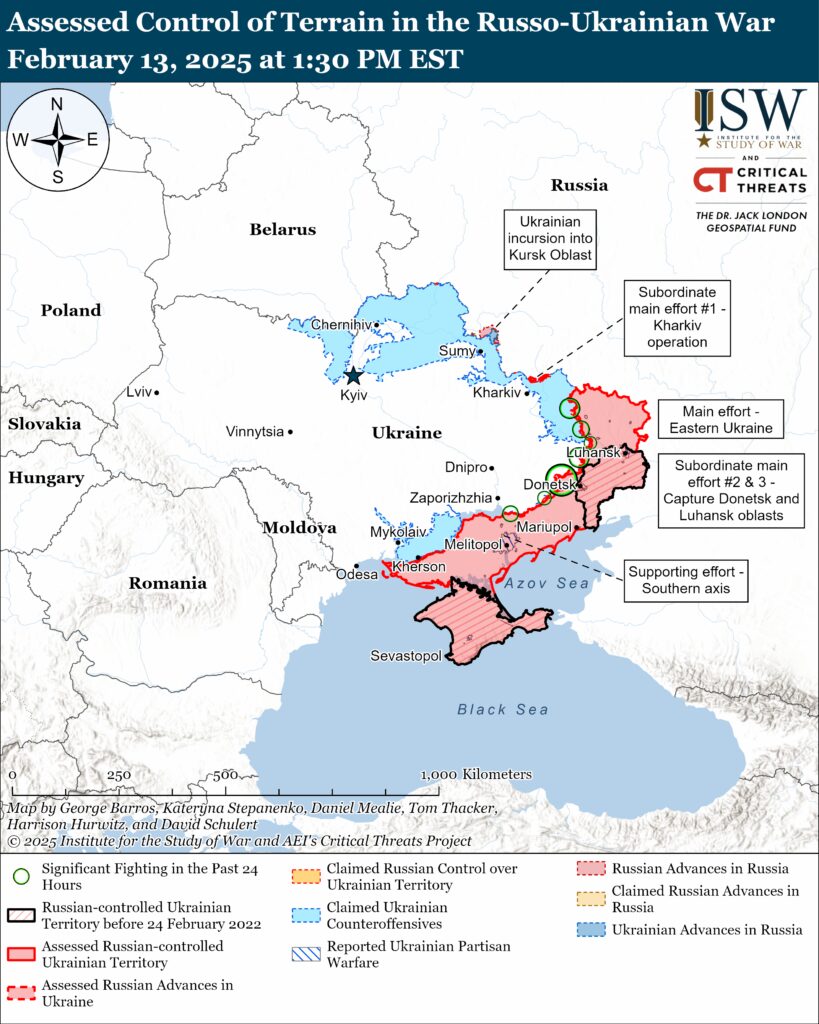
We do not report in detail on Russian war crimes because these activities are well-covered in Western media and do not directly affect the military operations we are assessing and forecasting. We will continue to evaluate and report on the effects of these criminal activities on the Ukrainian military and the Ukrainian population and specifically on combat in Ukrainian urban areas. We utterly condemn Russian violations of the laws of armed conflict and the Geneva Conventions and crimes against humanity even though we do not describe them in these reports.
Ukrainian Operations in the Russian Federation
Russian Main Effort – Eastern Ukraine (comprised of three subordinate main efforts)
Russian Subordinate Main Effort #1 – Push Ukrainian forces back from the international border with Belgorod Oblast and approach to within tube artillery range of Kharkiv City
Russian Subordinate Main Effort #2 – Capture the remainder of Luhansk Oblast and push westward into eastern Kharkiv Oblast and encircle northern Donetsk Oblast
Russian Subordinate Main Effort #3 – Capture the entirety of Donetsk Oblast
Russian Supporting Effort – Southern Axis
Russian Air, Missile, and Drone Campaign
Russian Mobilization and Force Generation Efforts
Russian Technological Adaptations
Activities in Russian-occupied areas
Significant Activity in BelarusUkrainian Operations in the Russian Federation
Fighting continued in the Ukrainian salient in Kursk Oblast on February 13. Russian milbloggers claimed that fighting continues west of Sudzha near Sverdlikovo and southeast of Sudzha near Cherkasskaya Konopelka.[29] A Russian milblogger claimed on February 13 that Ukrainian forces counterattacked near Kurilovka (south of Sudzha).[30]
Order of Battle: Elements of the Russian 106th Airborne (VDV) Division reportedly continue to operate near Cherkasskaya Konopelka.[31]
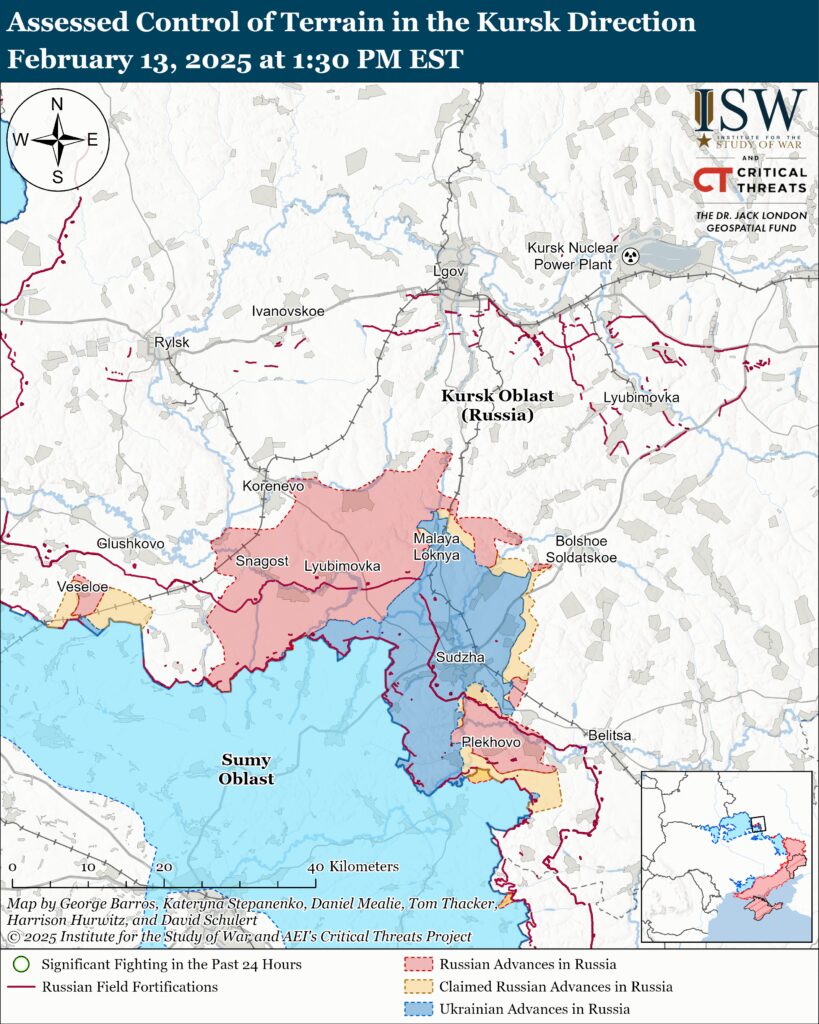
Russian Main Effort – Eastern Ukraine
Russian Subordinate Main Effort #1 – Kharkiv Oblast (Russian objective: Push Ukrainian forces back from the international border with Belgorod Oblast and approach to within tube artillery range of Kharkiv City)
Russian forces continued offensive operations north of Kharkiv City near Lyptsi on February 13 but did not make confirmed advances.[32]
Unconfirmed Russian-claimed advances: A Russian milblogger claimed on February 13 that Russian forces advanced up to 70 meters on the eastern outskirts of Vovchansk (northeast of Kharkiv City).[33]
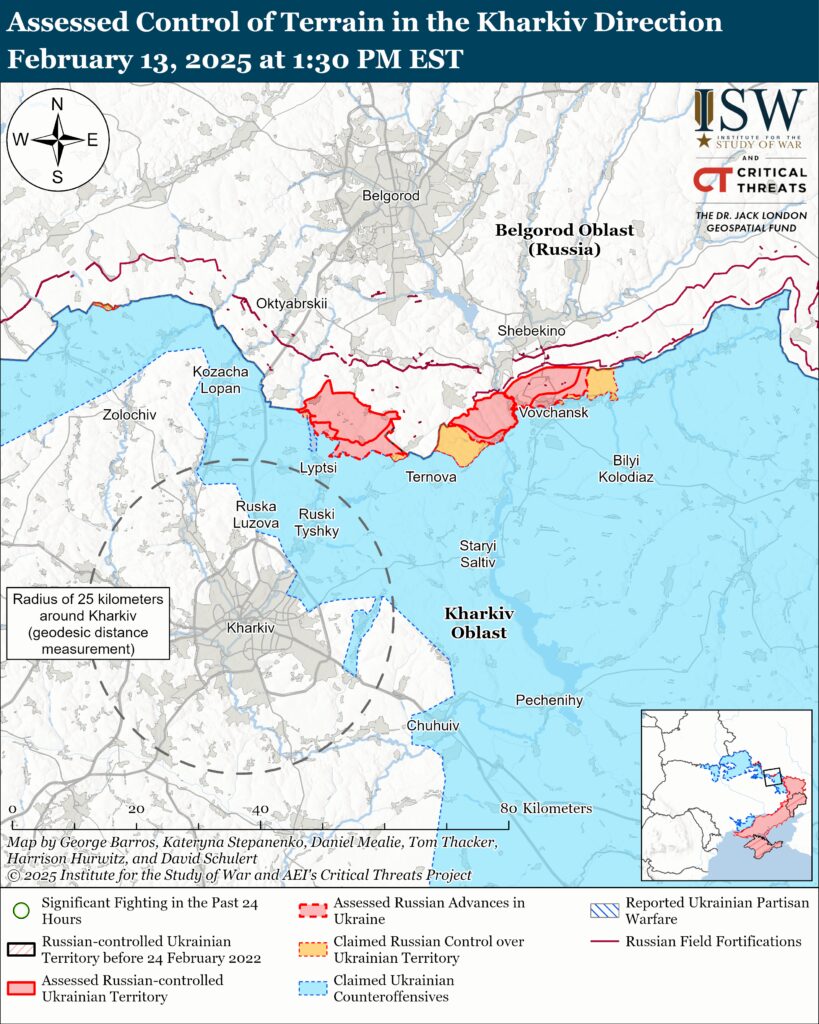
Russian Subordinate Main Effort #2 – Luhansk Oblast (Russian objective: Capture the remainder of Luhansk Oblast and push westward into eastern Kharkiv Oblast and northern Donetsk Oblast)
Russian forces continued offensive operations in the Kupyansk direction on February 13 but did not advance. Russian forces attacked north of Kupyansk near Kindrashivka, northeast of Kupyansk near Holubivka, east of Kupyansk near Petropavlivka, and southeast of Kupyansk near Stepova Novoselivka, Pishchane, and Novoosynove on February 12 and 13.[34]
Unconfirmed Russian-claimed advances: A Russian milblogger claimed on February 13 that Russian forces recently advanced 600 meters near Kindrashivka.[35]
Russian forces recently advanced in the Borova direction. Russian forces attacked northeast of Borova near Kolisnykivka, Zahryzove and Lozova; east of Borova near Kopanky; and southeast of Borova near Hrekivka and Novomykhailivka on February 12 and 13.[36]
Assessed Russian advances: The Ukrainian General Staff published a map on February 13 indicating that Russian forces likely recently advanced in fields west of Pershotravneve (east of Borova).[37]
Unconfirmed Russian-claimed advances: A Russian milblogger claimed that Russian forces advanced west of Makiivka in an area up to 4.5 kilometers wide and two kilometers deep.[38]
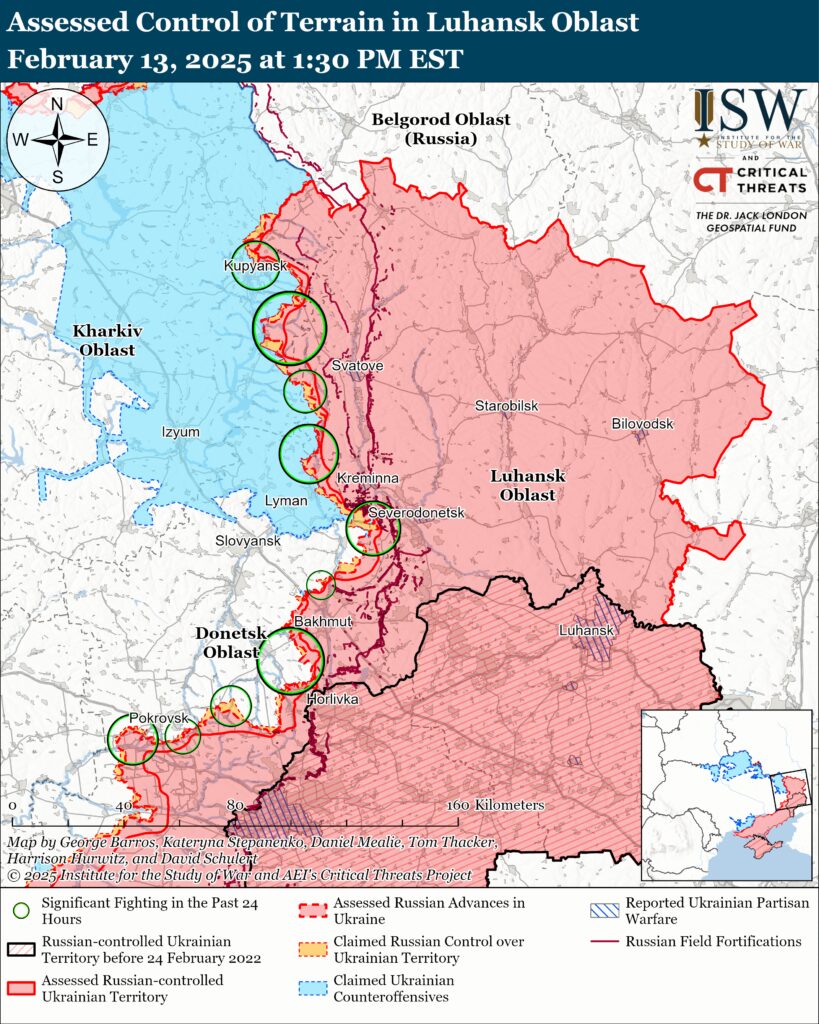
Russian forces continued offensive operations in the Lyman direction on February 13 but did not make any confirmed advances. Russian forces continued attacking northeast of Lyman near Yampolivka, Novolyubivka, and Kolodyazi on February 12 and 13.[39]
Unconfirmed Russian-claimed advances: A Russian milblogger claimed on February 12 that Russian forces advanced near Novolyubivka.[40]
Russian Subordinate Main Effort #3 – Donetsk Oblast (Russian objective: Capture the entirety of Donetsk Oblast, the claimed territory of Russia’s proxies in Donbas)
Russian forces recently advanced near Siversk. Russian forces continued attacks northeast of Siversk near Bilohorivka and east of Siversk near Verkhnokamyanske on February 12 and 13.[41]
Assessed Russian advances: The Ukrainian General Staff published a map on February 13 indicating that Russian forces likely recently advanced southeast of Fedorivka (south of Siversk).[42]
Russian forces continued offensive operations near Chasiv Yar and north of Chasiv Yar near Vasyukivka on February 12 and 13 but did not advance.[43]
Order of Battle: Drone operators of the Russian 1442nd Motorized Rifle Regiment (6th Motorized Rifle Division, 3rd Army Corps [AC]) are reportedly operating near Predtechyne (south of Chasiv Yar).[44]
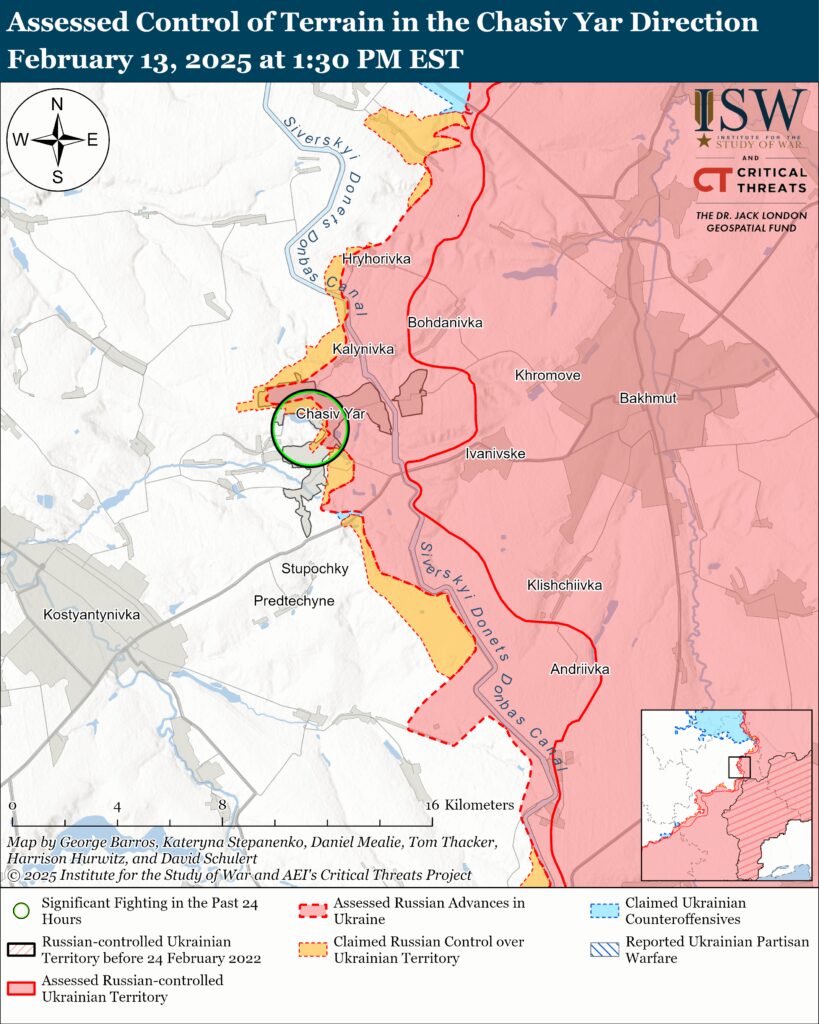
Russian forces continued offensive operations in Toretsk, west of Toretsk near Shcherbynivka, and southwest of Toretsk near Sukha Balka on February 12 and 13 but did not advance.[45] A Kremlin-affiliated Russian milblogger claimed that Russian forces repelled a small Ukrainian mechanized assault on the outskirts of Toretsk.[46]
Unconfirmed Russian-claimed advances: Russian milbloggers claimed that Russian forces recently advanced northeast and north of Toretsk, in southern Shcherbynivka, south of Petrivka (west of Toretsk), southwest of Leonidivka (southwest of Toretsk), and east of Valentynivka (southwest of Toretsk).[47]
Order of Battle: Elements of the Russian 109th Separate Rifle Regiment (1st “Slovyansk” Motorized Rifle Brigade, 51st Combined Arms Army [CAA], formerly 1st Donetsk People’s Republic [DNR] AC, Southern Military District [SMD]) are reportedly operating in Toretsk.[48]
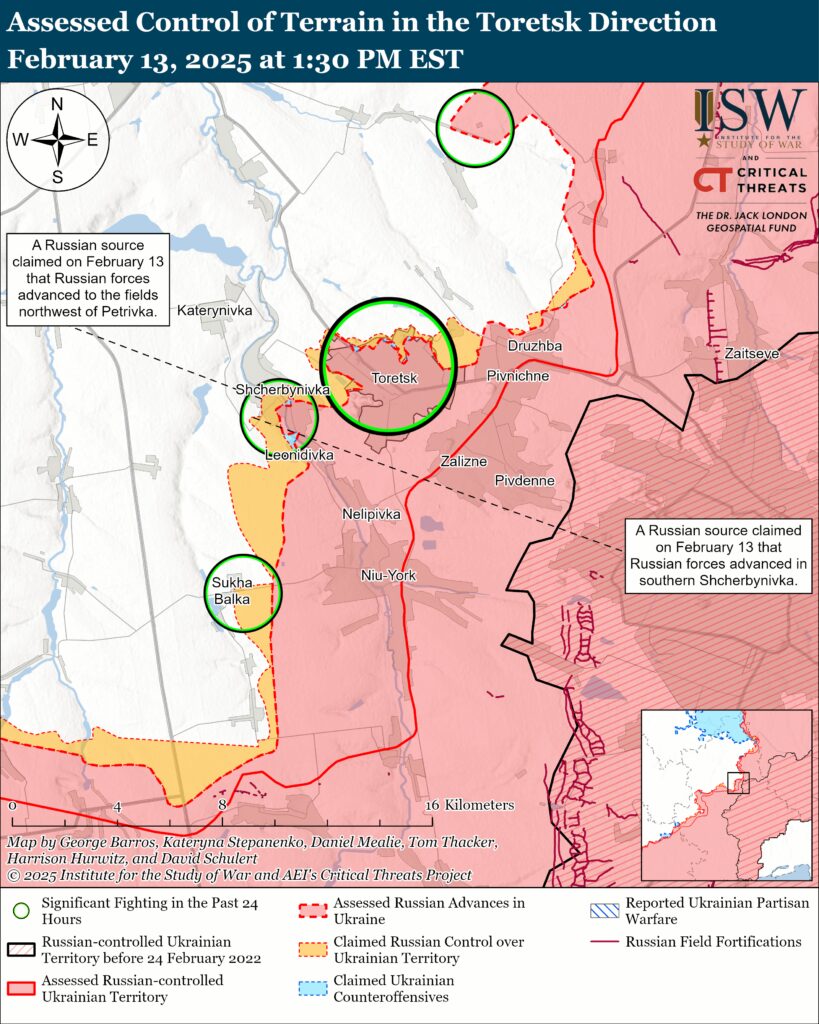
Russian forces continued offensive operations in the Pokrovsk direction on February 13 but did not advance. Russian forces attacked east of Pokrovsk near Zelene Pole, Vodyane Druhe, Tarasivka, Yelyzavetivka, Malynivka, and Promin; southeast of Pokrovsk near Lysivka; south of Pokrovsk near Zvirove and Pishchane; southwest of Pokrovsk near Udachne, Nadiivka, Zaporizhzhia, Preobrazhenka, and Uspenivka on February 12 and 13.[49] Khortytsia Group of Forces Spokesperson Major Viktor Trehubov reported that fighting remains intense south and southwest of Pokrovsk.[50] A Ukrainian brigade operating in the Pokrovsk direction posted footage on February 13 showing the brigade repelling a platoon-sized Russian mechanized assault in an unspecified area of this direction.[51]
Unconfirmed Russian-claimed advances: The Russian MoD claimed that Russian forces seized Vodyane Druhe as of February 13, but ISW has not observed confirmation of Russian forces operating in the settlement.[52] Russian milbloggers claimed that Russian forces seized Berezivka (northeast of Pokrovsk) and recently advanced towards Baranivka (northeast of Pokrovsk), Zelene Pole, Oleksandropil (northeast of Pokrovsk), Preobrazhenka, and near Sribne (southwest of Pokrovsk).[53] Other Russian milbloggers claimed that Russian forces retook positions in Pishchane’s industrial area and north of Kotlyne (southwest of Pokrovsk) and are advancing towards central Udachne.[54]
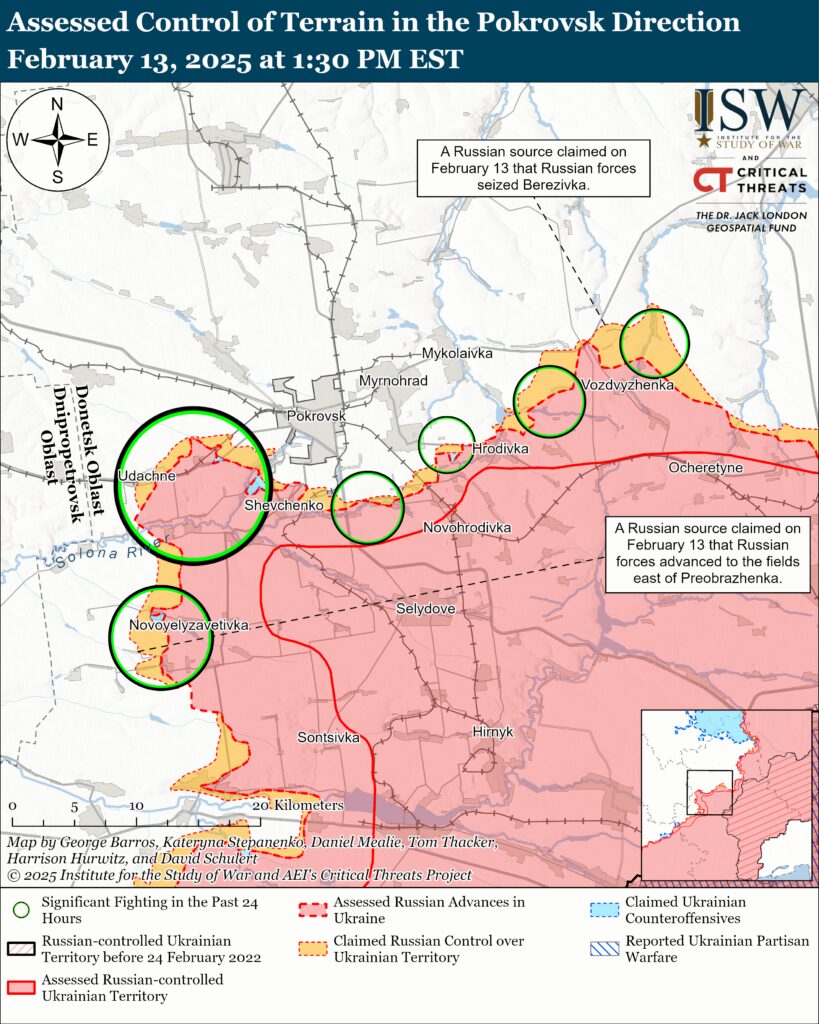
Russian forces continued offensive operations in the Kurakhove direction on February 13 but did not advance. Russian forces attacked northeast of Kurakhove near Andriivka and Shevchenko; west of Kurakhove near Dachne Ulakly, Kostyantynopil, Oleksiivka, Rozlyv, and Bahatyr; and southwest of Kurakhove near Zelenivka on February 12 and 13.[55]
Unconfirmed Russian-claimed advances: Russian milbloggers claimed that Russian forces advanced up to 1.5 kilometers northwest of Zelenivka, north of Andriivka, southwest of Dachne, and west of Slovyanka (northeast of Kurakhove).[56]
Order of Battle: Ukrainian military observer Kostyantyn Mashovets stated on February 13 that elements of the Russian 110th Motorized Rifle Brigade (51st CAA) are operating in the Shevchenko-Andriivka area and that elements of the 102nd and 102nd motorized rifle regiments and 163rd Tank Regiment (all of the 150th Motorized Rifle Division, 8th CAA, SMD) are operating in the Novopavlivka (Kurakhove) direction.[57] A Russian milblogger claimed on January 18 that the Russian military command redeployed elements of the 110th Motorized Rifle Brigade to the Pokrovsk direction near Zelene Pole.[58] A Russian source claimed on February 8 that the Russian military command redeployed elements of the 102nd and 103rd motorized rifle regiments, 163rd Tank Regiment, and 381st Artillery Regiment (all of the 150th Motorized Rifle Division) to the Toretsk direction, but ISW has not observed confirmation or other reporting on this alleged redeployment.[59] Elements of the 944th Self-Propelled Artillery Regiment (20th Motorized Rifle Division, 8th CAA) are reportedly operating near Kostyantynopil, and drone operators of the 39th Motorized Rifle Brigade (68th AC, Eastern Military District [EMD]) are reportedly operating near Ulakly.[60]
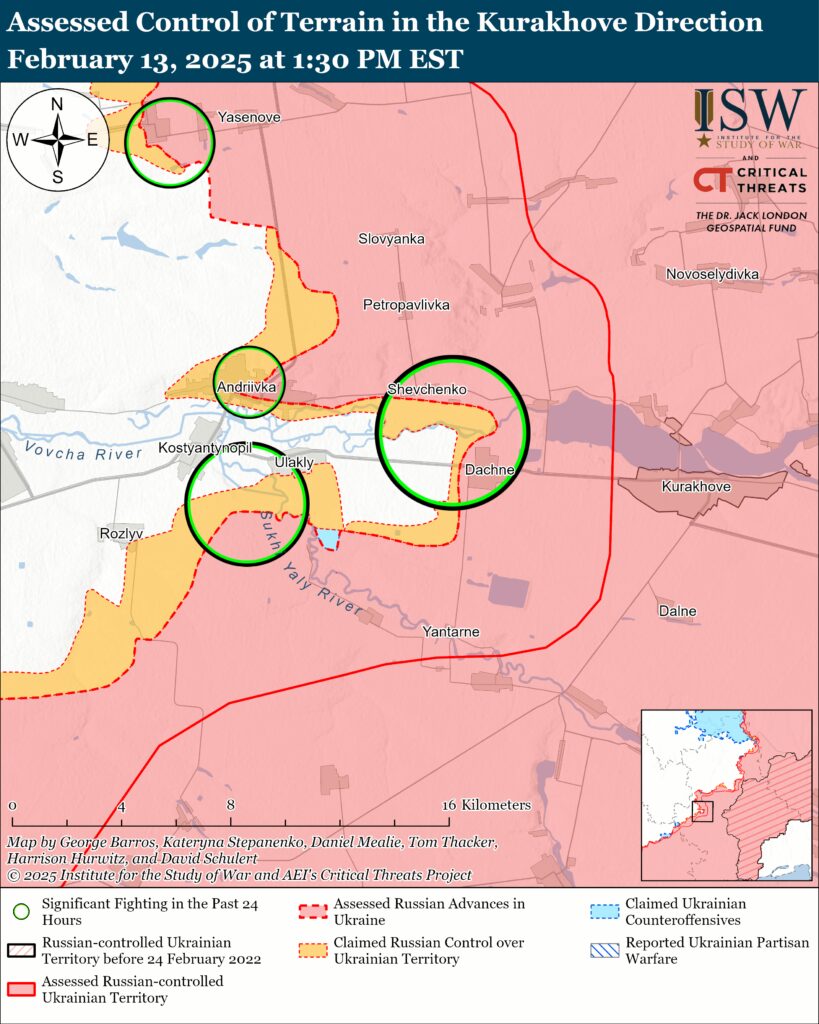
Russian forces continued offensive operations in the Velyka Novosilka direction on February 13 but did not advance. Russian milbloggers claimed that Russian forces attacked north of Velyka Novosilka near Novyi Komar and Novoocheretuvate; northwest of Velyka Novosilka toward Burlatske; west of Velyka Novosilka near Vremivka on February 12 and 13.[61]
Unconfirmed Russian-claimed advance: Russian milbloggers claimed that Russian forces advanced northwest of Velyka Novosilka, near Novyi Komar, and northwest and west of Vremivka.[62]
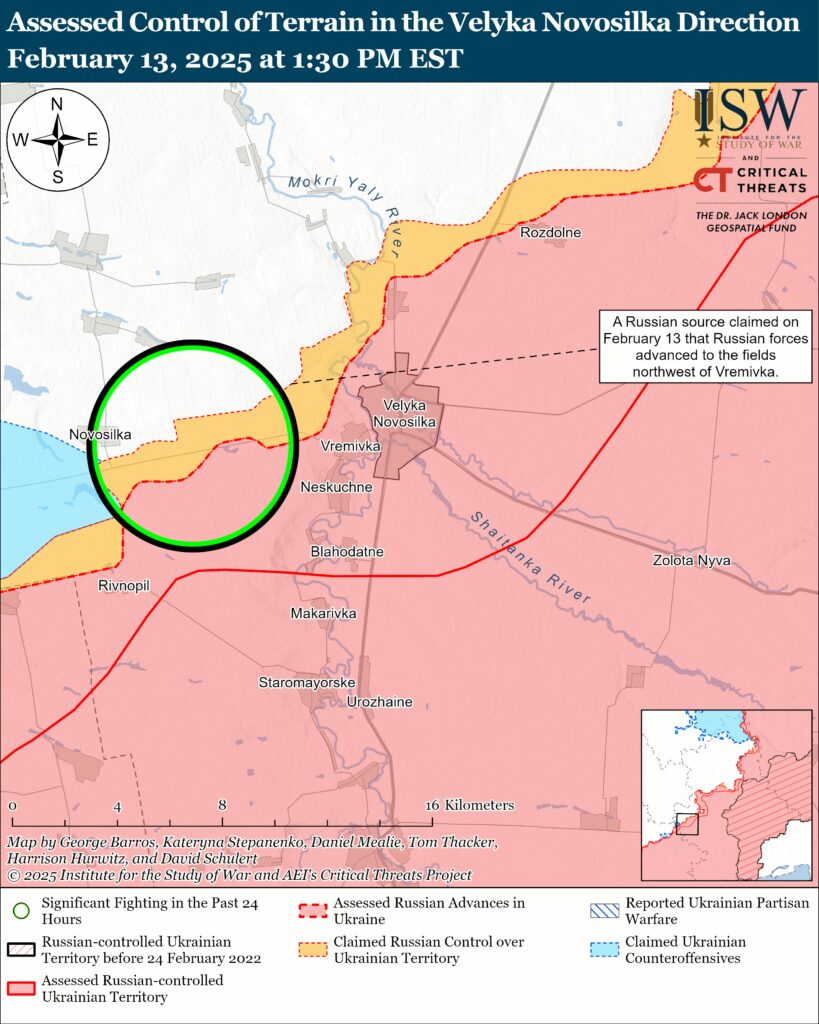
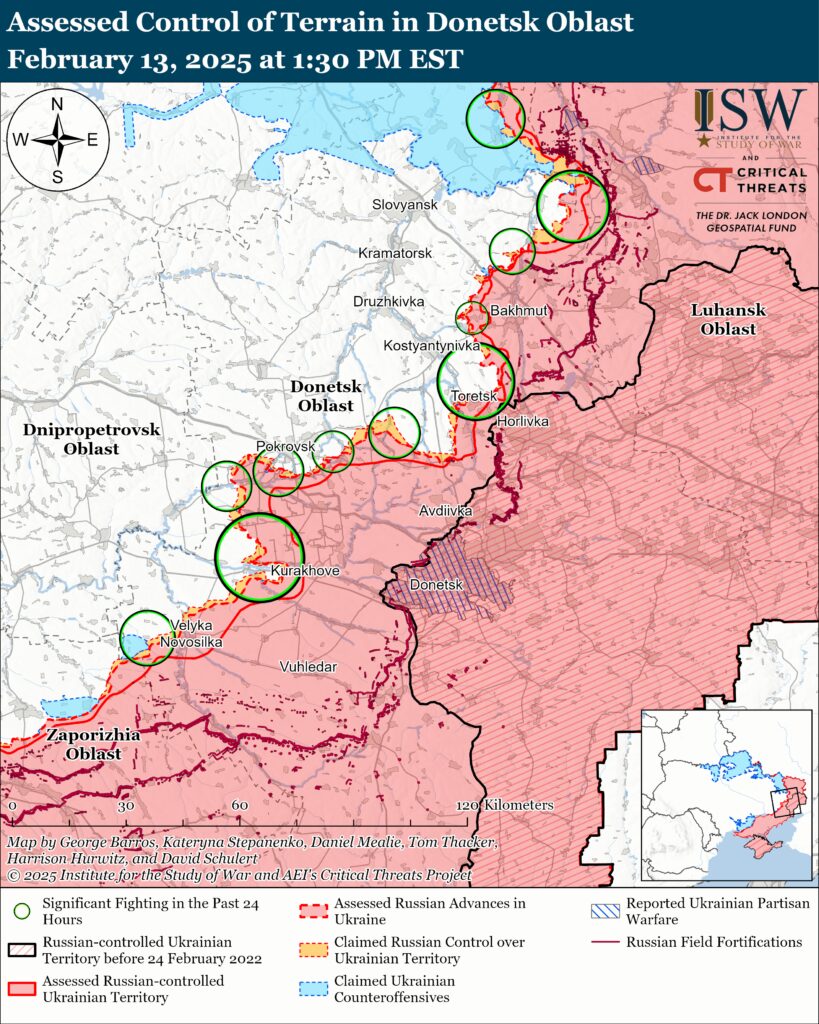
Russian Supporting Effort – Southern Axis (Russian objective: Maintain frontline positions and secure rear areas against Ukrainian strikes)
Russian forces continued ground attacks northwest of Robtyne near Shcherbaky and Kamyanske and northeast of Robotyne near Mala Tokmachka on February 13 but did not make any confirmed advances.[63] A Russian milblogger claimed that Ukrainian forces counterattacked near Kamyanske.[64]
Unconfirmed Russian-claimed advances: A Russian milblogger claimed that Russian forces advanced 300 meters toward Orikhiv.[65]
Ukraine’s Main Military Intelligence Directorate (GUR) reported on February 13 that Russian forces disrupting a scheduled rotation of International Atomic Energy Agency (IAEA) experts at the Russian-occupied Zaporizhzhia Nuclear Power Plant (ZNPP) on February 12.[66] The GUR reported that elements of the Russan 135th Motorized Rifle Regiment (19th Motorized Rifle Division, 58th Combined Arms Army [CAA], Southern Military District [SMD]) attacked Ukrainian positions in an area through which IAEA experts planned to travel. The Russian Ministry of Defense (MoD) claimed on February 13 that Ukrainian forces conducted artillery and drone strikes against a convoy of IAEA experts on February 12.[67] IAEA Director General Rafael Mariano Grossi stated on February 12 that “intense military activity” caused the IAEA to cancel a scheduled rotation of IAEA experts at the ZNPP.[68]
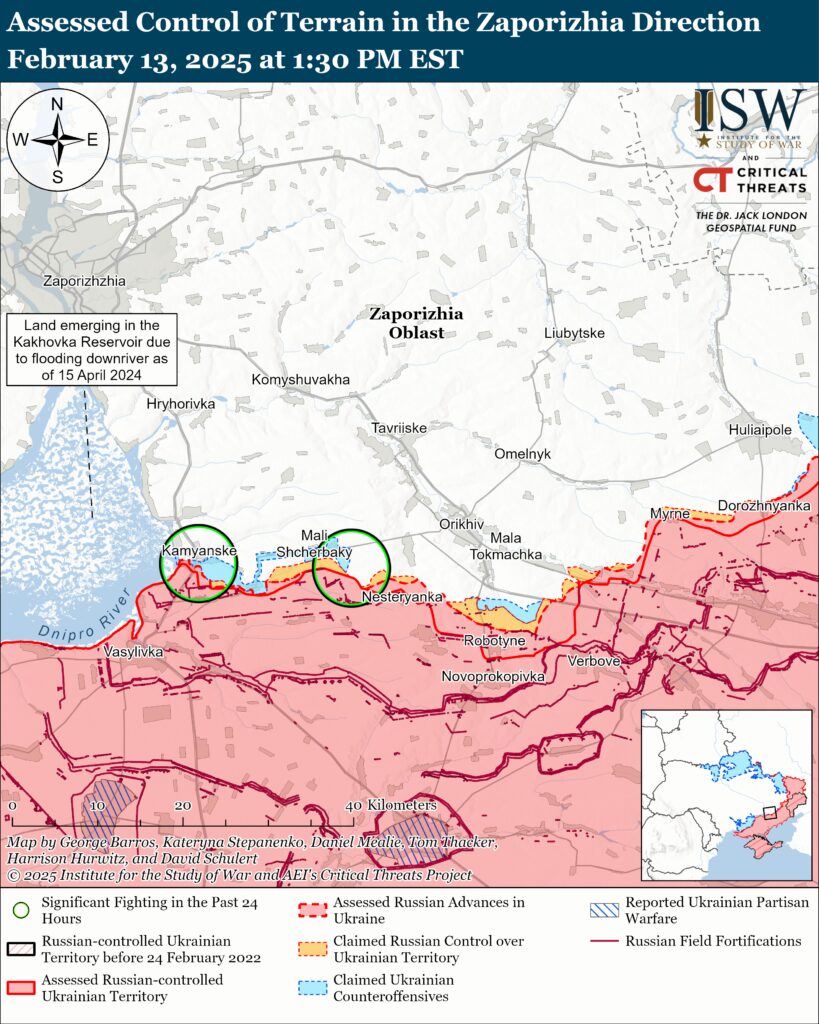
Neither Russian nor Ukrainian sources reported ground activity in the Dnipro direction on February 13.
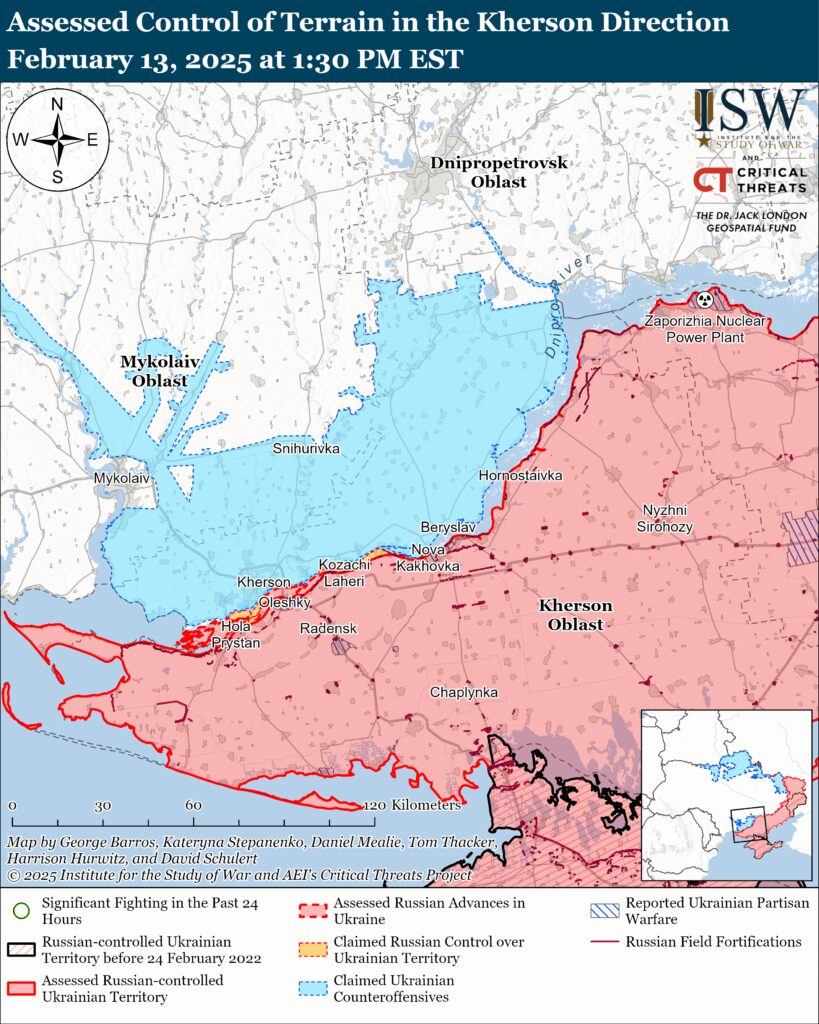
Russian Air, Missile, and Drone Campaign (Russian Objective: Target Ukrainian military and civilian infrastructure in the rear and on the frontline)
Russian forces conducted a series of drone strikes against Ukraine on the night of February 12 and 13. The Ukrainian Air Force reported that Russian forces launched 140 Shahed and decoy drones from Primosko-Akhtarsk, Krasnodar Krai; Shatalovo, Smolensk Oblast; and Oryol, Bryansk, and Kursk oblasts.[69] The Ukrainian Air Force reported that Ukrainian forces downed 85 drones over Kharkiv, Poltava, Sumy, Cherkasy, Chernihiv, Kirovohrad, Dnipropetrovsk, Mykolaiv, Kherson, and Odesa oblasts; that 52 drones were “lost,” likely due to Ukrainian electronic warfare (EW) interference; and that the strikes damaged unspecified infrastructure in Kharkiv Oblast. Ukraine’s Southern Operational Command reported on February 13 that Russian drone strikes damaged port infrastructure and an educational facility in Odesa Oblast.[70]
Russian Mobilization and Force Generation Efforts (Russian objective: Expand combat power without conducting general mobilization)
Russian officials continue efforts to increase recruitment for the “BARS-Bryansk” volunteer territorial defense detachment. Bryansk Oblast Governor Alexander Bogomaz claimed during a meeting with Russian President Vladimir Putin on February 13 that the “BARS-Bryansk” volunteer detachment has 1,800 personnel and that about 100 new individuals join the detachment every week.[71] Bogomaz stated that the regional government provides social benefits, equipment, accommodations, and uniforms for detachment personnel and pays personnel 300,000 rubles (roughly $3,350) when they join the detachment and an additional 600,000 rubles (roughly $6,700) if they sign a military service contract with the Russian MoD.[72] Russian authorities created the “BARS-Bryansk,” “BARS-Kursk,” and “BARS-Belgorod” detachments in response to the Ukrainian incursion into Kursk Oblast in August 2024 and intend to use the detachments to resettle Russian civilians in Russian border areas after Russian forces completely retake Kursk Oblast and defend against possible future incursions.[73]
Russian Technological Adaptations (Russian objective: Introduce technological innovations to optimize systems for use in Ukraine)
Nothing significant to report.
Activities in Russian-occupied areas (Russian objective: Consolidate administrative control of annexed areas; forcibly integrate Ukrainian citizens into Russian sociocultural, economic, military, and governance systems)
ISW is not publishing coverage of activities in Russian-occupied areas today.
Significant activity in Belarus (Russian efforts to increase its military presence in Belarus and further integrate Belarus into Russian-favorable frameworks)
Nothing significant to report.
Note: ISW does not receive any classified material from any source, uses only publicly available information, and draws extensively on Russian, Ukrainian, and Western reporting and social media as well as commercially available satellite imagery and other geospatial data as the basis for these reports. References to all sources used are provided in the endnotes of each update.
 Eurasia Press & News
Eurasia Press & News
